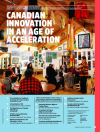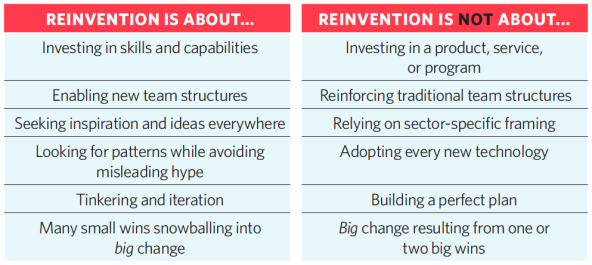In fall 2016, Emmett Carson, CEO of the Silicon Valley Community Foundation, spoke at the Calgary Foundation’s Annual Vital City event and shared his view of how philanthropy should be thinking about technology innovation and economic disruption. He talked about how technologies such as automation, machine learning, and artificial intelligence are ushering in the fourth industrial revolution. And he explained how these realities have influenced his foundation to make its donor engagement, advocacy, and grantmaking priorities both local and global in perspective and practice. Through the course of the speech, he repeatedly used the phrase “both/and” to highlight the benefits and unintended consequences that can result from rapid innovation.
Canadian Innovation in an Age of Acceleration

This special supplement highlights innovative social programs, collaborations, and movements underway among Canada’s diverse communities—150 years after the country’s founding—and shares ideas for others involved in similar efforts around the world.
-
The Critical Role of Traditional Knowledge in Social Innovation
-
A New Model for CSR
-
The Digital Future of Canadian Philanthropy
-
A Path to Community Driven Food Innovation
-
Fighting Social Exclusion, One Encounter at a Time
-
Supporting Women’s Rights in Troubled Times
-
An Invitation to Explore Indigenous Innovation
-
Out of the Lab and into the Frontline
-
Crowdsourcing Refugee Resettlement
-
Building a Canadian Social Finance Fund
-
Canada and the Sustainable Development Goals
Carson discussed, for example, how self-driving trucks are anticipated to eliminate thousands of long-haul trucking jobs. In this case, automation is both promising for the new firms creating self-driving fleets (e.g., Otto) and a cause of great concern, as it signals a massive labor force upheaval for the tens of thousands of truckers currently employed in North America. He also shared a story of a hands-free soap dispenser that dispenses for people with lighter skin but does not for those with darker skin because the infrared sensor was not properly calibrated before it was sent to market. This example highlighted the unintended, negative consequences that can arise from technical innovation and the importance of diversity on technology teams when designing and testing products.
Carson’s perspective on the importance of understanding technology’s opportunities and drawbacks informs several aspects of our social research and development strategy here at GrantBook, a Toronto-based organization that helps grantmakers and impact investors develop digital strategies. In fact, over the past 24 months, motivated in part by Carson’s words, we have been pursuing the following line of inquiry:
- What industries are undergoing substantial and rapid change?
- What kinds of companies/organizations are leading the disruption?
- How are these entities building/empowering their teams and attracting top talent?
- What kinds of job descriptions best reflect their innovative approaches and forwardthinking mind-sets?
- How can we apply a social lens to research and development/human-centered design techniques that can benefit philanthropy?
- Based on the above, what are the implications for philanthropy, and specifically for philanthropic leaders?
We encourage philanthropic leaders and social-impact investors to ask the same sorts of questions. In doing so, they may find, as we have, that other sectors are using digital in ways that the social sector can learn from and build on.
Consider, for example, Kabbage.com, a company that is reinventing how small business can apply for a line of credit, and Scotiabank, a Kabbage investor and partner.
Within five minutes of creating an account with Atlanta-based Kabbage.com, businesses can be approved for a credit line of up to $100,000. The platform, launched in 2009, is a beautifully designed software application. It uses two powerful software concepts (APIs and machine learning) that securely connect online bank accounts, merchant platforms (e.g., Etsy, PayPal, and Stripe), and accounting software (e.g., QuickBooks, Xero, and Sage). Kabbage .com’s value proposition is simple and compelling: “Spend time on your business—not paperwork.” As of this writing, Kabbage is hiring over a dozen employees (data scientists, security architects, integration specialists, and more).
In October 2014, Canada’s Scotiabank joined others in a Series E round of investing in the company, contributing to its current $1.3 billion valuation. Scotiabank has also invested or partnered with other fintech startups, such as AlphaPoint (blockchain), DeepLearni.ng (artificial intelligence), NextAI (artificial intelligence), and Sensibill (machine learning and APIs). These startups are hiring and empowering small, highly collaborative teams with diverse skill sets. They employ agile project managers, consumer insight heads, user experience designers, and API developers to deliver services and products to meet users’ needs in novel, useful, intuitive ways.
Scotiabank’s external investment in this portfolio of organizations is concurrent with its own internal digital transformation. The focus of the Scotiabank Digital Factory, a 500-person innovation lab based in Toronto, is “moving Scotiabank forward through experimentation and reinvention.” Additionally, Scotiabank is financing Canadian research and creation of new digital competencies via the Scotiabank Centre for Customer Analytics at Queen’s University, Scotiabank Digital Banking lab at Western University, and Scotiabank Design Thinking Partnership at OCAD. Collectively, these substrategies signal that a large, generally slow-moving bank is ready for the future.
The return on investment? Scotiabank has made excellent progress advancing its digital strategy, as stated in its 2016 Annual Report and reported by the independent research firm International Data Corp. The bank’s transformation strategy is rooted in both a strong risk assessment culture and a decision to ensure the continued relevance of its business model through a diversified revenue mix and better products for customers.
Drawing on Others’ Methodologies
Foundations, like banks, have strong risk assessment cultures. From their investment strategies to their granting approaches, most foundations have instituted policies and procedures protecting their assets while applying rigor to their grant application and reporting platforms. However, as documented by Project Streamline (an initiative of PEAK Grantmaking, a member-led organization of and for grantmakers), the process of applying for and reporting on grants remains very time-consuming and labor-intensive.
Despite the growing number of promising online technologies available to philanthropic groups, connecting software effectively and securely so that grantmaking and grant-seeking staff can focus on mission—not clerical tasks—remains a challenge. This is less a technological hurdle than a design and change-management exercise. A Kabbage-like platform approach in philanthropy—one that involves several concurrent investments and experiments—could vastly reduce transaction costs while producing considerably more useful information.
Making the Case for Digital Strategy
Digital reinvention for a philanthropic organization needs to include both internal and external transformation. With that in mind, here are a few questions that leaders can ask to kick-start a conversation within their organizations about how to prepare for the future:
- What are the new skills and novel partnerships we will need in order to take advantage of the wealth of data and information available to solve societal challenges?
- How can we empower small yet mighty teams to deliver programs and services that “surprise and delight” the most vulnerable people or communities?
- How can we modify and support office environments such that powerful machines support (not eliminate) talented humans and reduce redundant tasks?
With billions of existing dollars available for the purposes of social good, the economic case for philanthropic organizations to kick-start a digital strategy is strong. In fact, if philanthropic organizations want to make their programs and services both effective and scalable, then creating a digital strategy that is aligned with their strategic plan is a governance imperative.
Economic, social, and environmental systems are already becoming more interconnected, facilitating the rapid evolution of products and services designed to meet the needs of the most vulnerable. Philanthropic organizations need to build digital muscle to respond effectively to the torrent of ideas and information.
Canada’s Increasingly Digitally Enabled Social Sector
Billions of new dollars are pouring into Canada’s big data, machine learning, and artificial intelligence (AI) industries. The mission of the Vector Institute (founded in 2015), for example, is to “promote and maintain Canadian excellence in deep learning and machine learning.” And the Canadian Institute for Advanced Research (CIFAR) soon will be administering a $125 million pan-Canadian effort to attract and retain top AI researchers at our leading academic institutions.
These announcements, among others, have encouraged a number of Canadian civil society organizations to apply a social purpose lens to otherwise commercial pursuits of research and development. For example:
InWithForward is piloting a novel shared-service platform, available to several social service organizations that could not otherwise afford their own internal research and development (R&D)/innovation departments. InWithForward’s rapid prototyping methodology includes an ethnographic approach to collecting small data—tiny clues that can help reveal large trends.
Open North has been leading Canada’s nonprofit open data movement and has been a champion of the International Open Data Charter. Globally, Open North promotes increased government transparency and accountability and greater public participation in democracy.
Powered by Data is working with Canadian funders to open up their grant data in machine-readable formats. This service has a number of social purposes, such as reducing the reporting burden for nonprofits and increasing grant effectiveness.
Code for Canada helps bring government innovators and civic technologists together to make life better for Canadians. It runs a series of workshops and delivers fellowship programs to improve technology and design capabilities within government.
Community Foundations of Canada is developing a data hub to better collect, curate, and share data and information with its members and as part of its movement building. This work includes partnering with other community foundations around the world on topics of inequality and reconciliation and mobilizing a network of domestic partners that are participating in Canada’s rollout of the Sustainable Development Goals.
As these examples illustrate, Canada is a hotbed for social innovation. And that means that now is an excellent time for philanthropic organizations to further invest in a digital strategy for the purposes of more effective grantmaking and philanthropy that results in social change. The intersection of innovation, philanthropy, and the future of work (driven by big data, APIs, AI, and deep learning) presents as many philosophical questions as technical ones. These include:
- Do we allow commercial-driven companies to dominate the development of AI products and services, or do we find ways to participate in cocreation?
- Do we allow others to define data ownership, or do we help shape it?
- How do we reduce commercial innovation blind spots and unintended consequences?
- How do we attract and support a network of smart and passionate people to participate in social R&D?
- How can Canada establish a credible social R&D practice that can lead globally?
- With whom around the globe should Canadian social R&D practitioners be engaging?
Philanthropy is at a crossroads in Canada and around the world. As a sector, it can continue to operate as it does today, or it can invest in internal and external transformation that requires reinvention at the root.

At GrantBook, we’re planning to expand our own social R&D (experimentation with human-centered design and APIs) while engaging with other like-minded practitioners. We want to see our individual and collective action produce both insights and capabilities to keep Canada at the forefront of innovation, philanthropy, and the future of work. Our doors are open to others who share that goal.
Support SSIR’s coverage of cross-sector solutions to global challenges.
Help us further the reach of innovative ideas. Donate today.
Read more stories by Anil Patel.

